What is hyperbaric medicine?
Medical information reviewed by Dr. Sturz Ciprian, Dr. Tîlvescu Cătălin și Dr. Alina Vasile
Article updated on: 16-12-2024
Hyperbaric medicine is an accredited form of medical treatment that involves placing the patient in a specially designed chamber, called a barochamber, where a pressure greater than normal atmospheric pressure is produced. In this environment, the patient inhales pure (100%) oxygen, usually through a mask. Therefore, the level of oxygen in the blood increases significantly, up to 20 times, facilitating the transport of oxygen to deficient areas of the body. The result is faster healing. Due to the increased pressure in the barochamber, the patient's lungs capture oxygen much more efficiently. Thus, the high concentration of oxygen in the blood contributes significantly to an accelerated recovery of the affected tissues.
Hyperbaric therapy has proven to be an effective treatment for various acute medical conditions, while also serving as a complementary treatment for many other health problems. The list of indications for this type of therapy is constantly expanding, with additional recommendations periodically introduced by the European Committee of Hyperbaric Medicine (ECHM) and the US Food and Drug Administration (FDA).
2019 Nobel Prize for Medicine, awarded for research on the way cells detect and respond to changes in oxygen levels has generated a new wave of interest and development in hyperbaric therapy, building on decades of experience in this field.
At the Hyperbarium clinic, hyperbaric medicine is practiced under the expertise of a team of doctors with skills in hyperbaric medicine, a team led by the medical director, Dr. Sturz Ciprian, with over 15 years of experience at some of the most famous hospitals in Germany, including Klinikum Nürnberg and Klinikum Roth. In the Hyperbarium clinic, the strictest safety protocols are followed, in a state-of-the-art hyperbaric chamber with 16 seats.
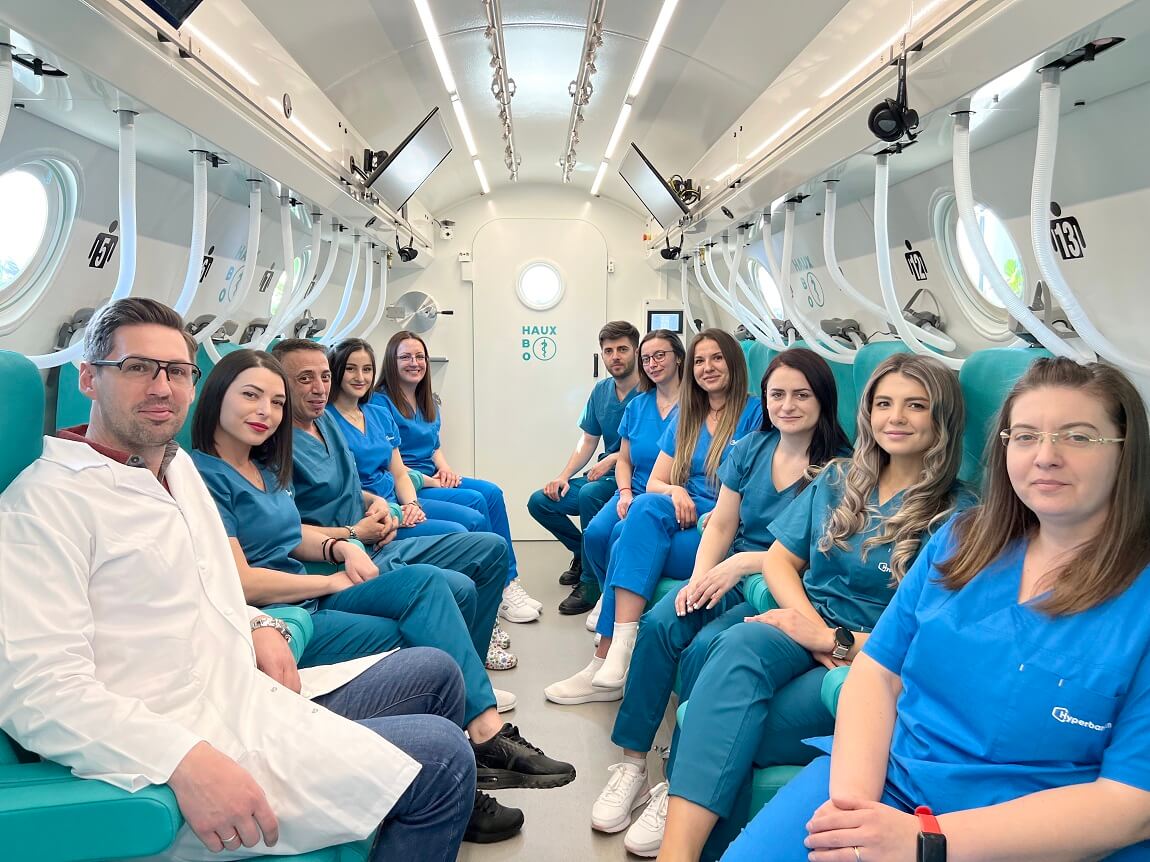
Next, we'll give you a detailed overview of hyperbaric medicine, covering everything from its benefits to the range of conditions that can be treated with this method. Use the links below to navigate directly to the sections that interest you:
Table of Contents
- What are the benefits of hyperbaric medicine?
- How does hyperbaric therapy work?
- What does a hyperbaric chamber look like?
- How does a hyperbaric treatment session work?
- What are the conditions treated by hyperbaric medicine?
- How safe is hyperbaric therapy?
- How much does a hyperbaric therapy session cost?
- Is hyperbaric therapy cleared by CAS?
- What should you expect after a hyperbaric therapy session?
- What are the results of hyperbaric therapy?
- What are the risks and contraindications?
- What makes Hyperbarium Clinic exceptional?
What are the benefits of hyperbaric therapy?
Some of the most important benefits of hyperbaric therapy include:
- Improving wound healing: By increasing tissue oxygen levels, hyperbaric therapy speeds up the wound healing process, especially for chronic, incurable wounds.
- Improving blood circulation: Favors tissue oxygenation and can help in the treatment of vascular conditions.
- Treatment of certain serious infections: Effective against infections resistant to conventional treatments, being an excellent adjunctive treatment.
- Relief of chronic pain: May reduce symptoms in chronic pain conditions.
- Support in recovery from cancer treatment: May help alleviate the side effects of cancer treatments.
- Treatment of carbon monoxide poisoning: It is considered a standard treatment for carbon monoxide poisoning, helping to quickly remove this toxic gas from the blood.
- Fast recovery in sports: Hyperbaric therapy is used by professional athletes to speed up recovery from sports injuries.
These are just some of the benefits of hyperbaric therapy. The complete list is much more extensive and continues to evolve. If you want to learn more about all the benefits and conditions treated, visit the following sections:
How does hyperbaric therapy work?
The air we breathe contains about 21% oxygen. When we inhale, this oxygen enters the lungs, where it is taken up by red blood cells, called red blood cells. These cells contain hemoglobin, a substance that binds to oxygen and carries it through the blood throughout the body. Blood circulates through veins and arteries, bringing oxygen to all tissues and organs of the body. In the tissues, oxygen is released from the red blood cells and enters the cells that need it. This continuous and vital process ensures the proper functioning of all parts of the body. The image below illustrates how oxygen from the air is taken up and distributed to cells in different parts of the body.
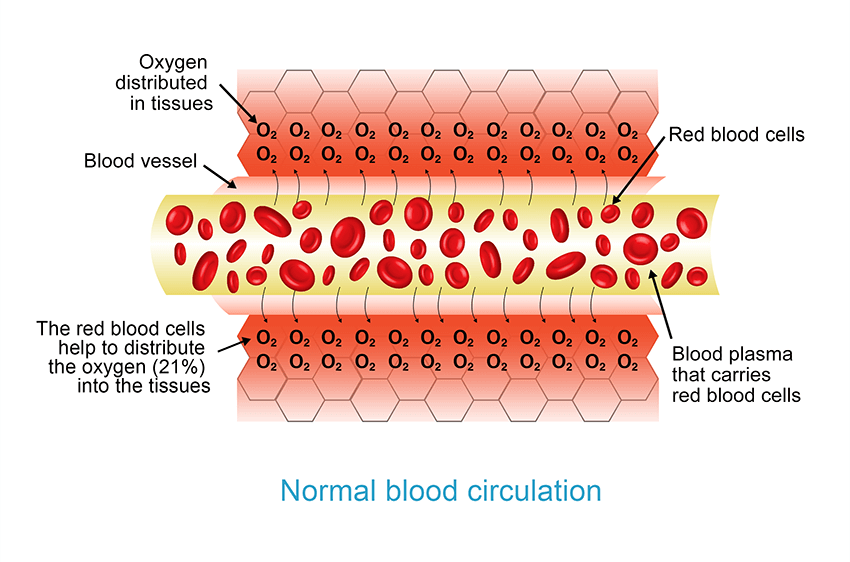
When blood vessels in the body become narrowed due to disease, they can no longer deliver enough oxygen to the tissues. This can lead to problems such as swelling, pain and even cell death, especially in chronic or serious diseases. Hyperbaric therapy addresses this problem by delivering pure oxygen in a chamber pressurized to 3 atmospheres ATA, thereby allowing more oxygen to reach the affected areas, even when the blood vessels are narrowed. Therefore, oxygen can help heal tissues and prevent cell death, thus providing important support for problems caused by lack of oxygen. The image below illustrates this sequence of events, from narrowing of vessels to tissue damage due to lack of oxygen.
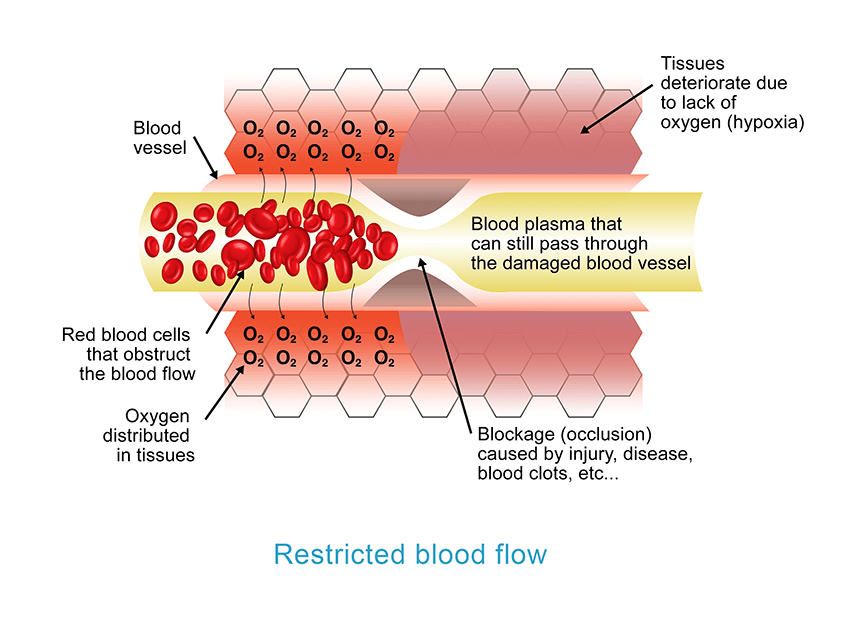
When we breathe pure oxygen (that is, 100% oxygen), in a pressurized chamber up to 3 atmospheres ATA, it penetrates much more easily into the tissues of our body. Even with blockages in blood vessels, hyperbaric oxygen can reach up to three times as far as normal. Thus, areas of the body that were not receiving enough oxygen begin to be better oxygenated, improving their functioning. For example, symptoms such as swelling and pain, which often occur when tissues do not receive enough oxygen, can be alleviated with hyperbaric therapy. This treatment also stimulates the formation of new small blood vessels, thus improving circulation and tissue oxygenation. The image below shows how, through hyperbaric therapy, oxygen reaches much deeper into the tissues through the intercellular fluid and plasma, even in the presence of a vascular blockage.
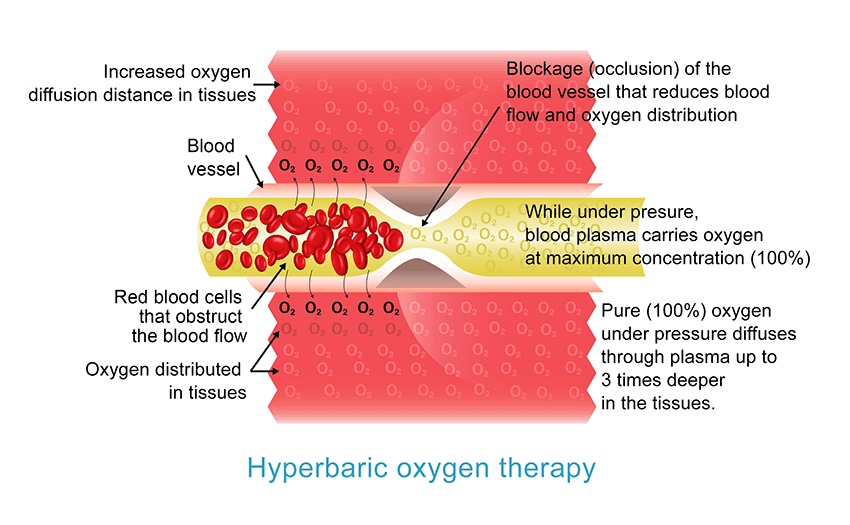
An article published in November 2006 in the American Journal of Physiology examined in detail how hyperbaric therapy helps repair body tissues. A particular blood cell called CD34+ has been found to play a key role in this process. This cell, originating from the bone marrow, doubles in number after only two hours of hyperbaric therapy. After 20 such treatments, the number of these cells in the blood increases eightfold.
In the image below, we can see how pure oxygen (100%) administered in a specially pressurized barochamber, forces diffusion into the tissues and encourages the formation of new blood vessels:
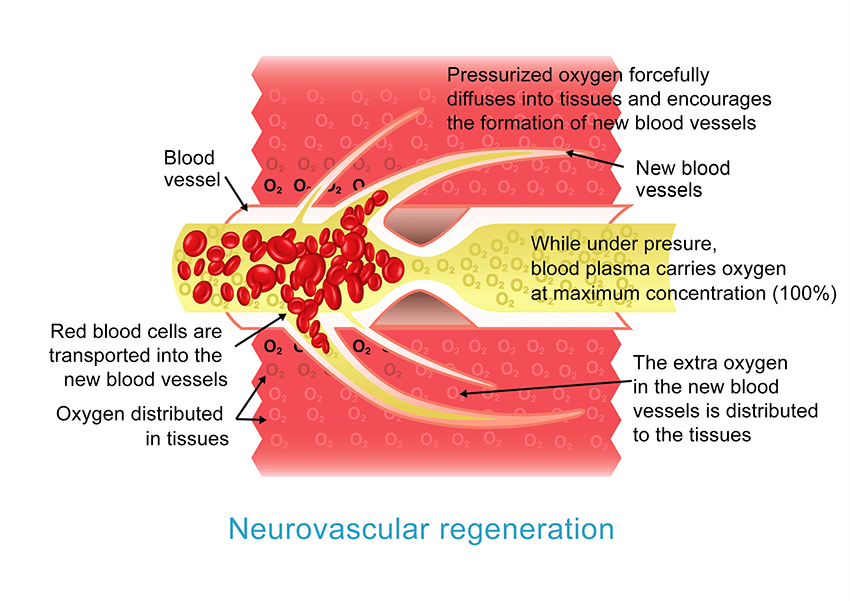
To effectively treat medical conditions, hyperbaric oxygen therapy is part of a complex treatment plan, customized according to the patient's therapeutic needs and pre-existing conditions. This plan may also include other therapies or treatment regimens designed to fit each patient's unique needs.
What does a hyperbaric chamber look like?
A hyperbaric chamber, essential in hyperbaric medicine, is a fully enclosed, pressurized device specifically designed to allow patients to inhale pure oxygen at a higher than normal atmospheric pressure.
The modern hyperbaric chamber of the Hyperbarium clinic, visible in the video above, is manufactured in Germany and is certified as a Class IIB medical device in accordance with EEC 93/42. It works with medical oxygen of 100% purity, and the maximum working pressure is 3 ATA, according to FDA, UHMS and ECHM (European Committee of Hyperbaric Medicine).
How does a hyperbaric treatment session work?
To begin the treatment and recovery program, a prior consultation and full evaluation by a specialist in hyperbaric medicine is required. During the initial consultation, you will be medically evaluated, and depending on the treatment indication, you will receive details about the procedure of hyperbaric oxygen therapy sessions. The treatment plan will be established, including the total number of recommended sessions, their duration and frequency. You will also be explained the indications, contraindications, potential risks of the therapy and a radiological screening will be performed to evaluate them. You will also be shown and explained the safeguards necessary to ensure that all patients benefit from hyperbaric oxygen therapy at the highest safety standards.
Hyperbaric oxygen treatment is non-invasive and painless. During the treatment, you will only feel a slight temporary pressure in the ears caused by the variation in air pressure, similar to the feeling in an airplane or at high altitude. This sensation is quickly relieved using techniques indicated by the medical staff.
The duration of hyperbaric oxygen therapy varies depending on the condition, and the recommended treatment regimen may last several hours. To make the experience as pleasant as possible, the hyperbaric chamber in the Hyperbarium clinic is equipped with an audio/video entertainment system, and throughout the treatment you will be carefully guided and monitored by the medical staff.
Any drug treatment you follow will be evaluated by specialist doctors, who will communicate any necessary changes. For your convenience, the Hyperbarium clinic offers a cloakroom equipped with secure lockers, where you can store your personal belongings during treatment.
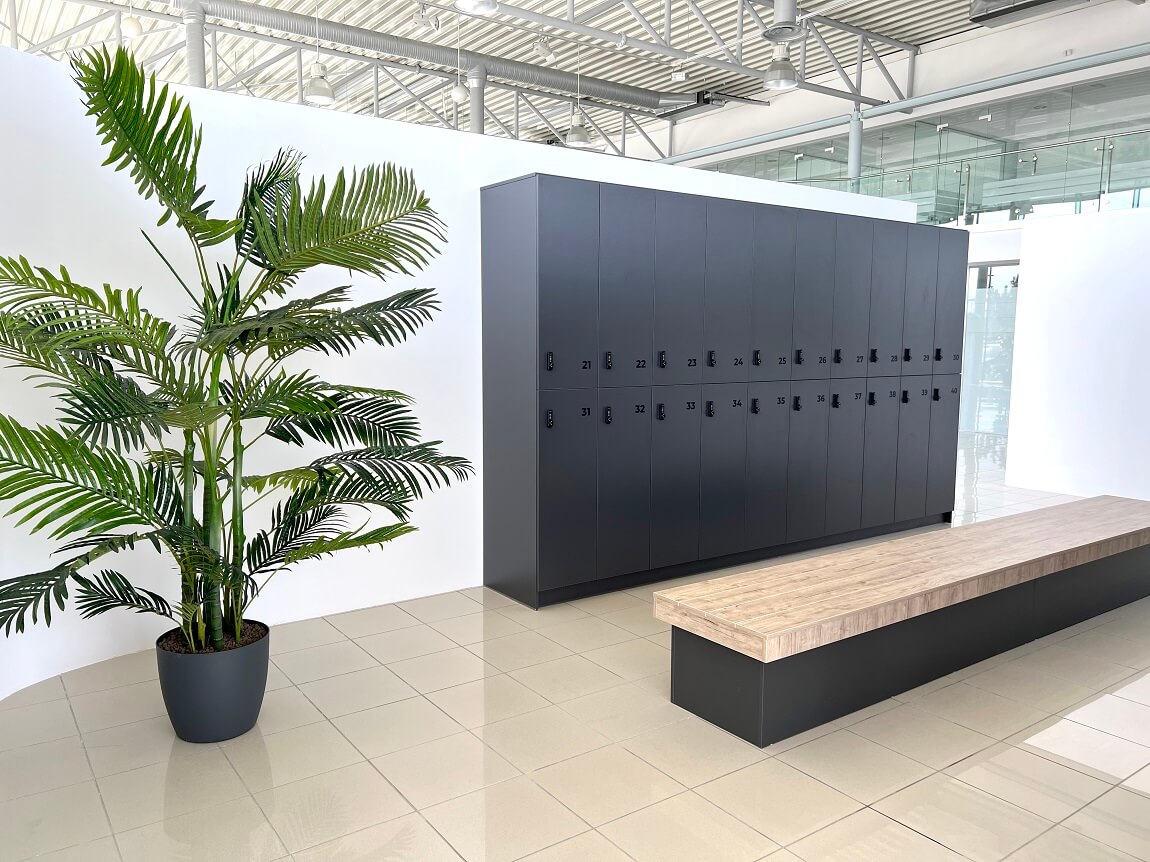
Before each hyperbaric treatment, you will be reminded of the safety rules and undergo a general assessment, including the measurement of pulse, blood pressure and glycemic control for patients with diabetes. To benefit from hyperbaric therapy in maximum safety, it is essential to wear clothing made of 100% cotton. Access to the room with electronic devices, materials or flammable substances is strictly prohibited.
In the hyperbaric chamber, patients relax in a controlled and safe environment, under the careful supervision of specialists. In the pressurized hyperbaric chamber, they breathe pure oxygen through a special mask. Patients experience a calm and comforting atmosphere.

During hyperbaric oxygen therapy, the amount of oxygen in the plasma increases significantly, up to 20 times higher than normal. This oxygen-rich blood circulates through the body and penetrates deep into the tissues, including areas where blood circulation is reduced or blocked. Thus, oxygen reaches the cells of the body much more easily than the circulatory system could transport alone.
After the session, you will be examined by a member of the treatment team, and you can then resume your normal daily activities. Hyperbaric oxygen therapy does not restrict normal daily activities.
What are the conditions treated by hyperbaric medicine?
Hyperbaric medicine is approved to treat a wide range of conditions. The FDA has approved this therapy for 14 different conditions, while the European Committee on Hyperbaric Medicine (ECHM) has already recognized its benefits in over 30 conditions. There are also hundreds of clinical trials, both completed and ongoing, that support the use of this therapy.
The European Hyperbaric Medicine Committee classifies the conditions for which it recommends hyperbaric medicine into several categories:
| Grade 1: Strong recommendation | Grade 2: Recommended | Grade 3: Optional | Other indications: |
|---|---|---|---|
|
|
|
|
| Grade 1: Strict recommendation |
|---|
|
| Grade 2: Recommended |
|---|
|
| Grade 3: Optional |
|---|
|
| Other indications: |
|---|
|
For a complete presentation of the indications, visit the following sections:
There are hundreds of completed studies in the field of hyperbaric medicine, and the doctors at Hyperbarium have classified these studies into categories to facilitate access and consultation. If you are interested in exploring them in detail, access the scientific studies section of the Hyperbarium website.
How safe is hyperbaric therapy?
Information provided by the FDA, but also numerous scientific studies show that when properly applied, in accredited medical centers, hyperbaric therapy can be considered one of the safest medical treatments available.
According to European and international norms in the field of hyperbaric medicine, for the safety of patients and medical staff, multi-place hyperbaric chambers are equipped with pneumatically activated fire fighting systems. They also include two patient access ways and a hatch that also serves as an emergency entrance for medical staff.
In multi-place barochambers, the application of oxygen during the therapy is done through an individual mask, in a pressurized chamber. It is important to note that in multiplace chambers the treatment is not carried out directly under oxygen pressure, and any increase in the oxygen concentration in the barochamber is carefully monitored by the operator team, who follow specific safety procedures.
The team of doctors specializing in hyperbaric medicine at the Hyperbarium clinic, led by Dr. Sturz Ciprian, urges everyone interested in hyperbaric therapy to be careful when choosing a hyperbaric chamber and to pay particular attention to the following three critical aspects to ensure a safe and effective experience:
- To ensure that the barocamera is medically accredited and operated by certified personnel according to the rules in force.
- Ensure that the pressure in the chamber can reach 3 ATA. (ATA pressure is composed of the value of the atmospheric pressure 1 bar + the value of the additional pressure in the hyperbaric chamber)
- Ensure that oxygen inspired during therapy is purity greater than 99.5%.
At the Hyperbarium clinic, hyperbaric therapy is carried out at the highest standards, offering optimal conditions of comfort and safety. Strict operational protocols, which include initial medical assessments and constant in-room medical monitoring, are crucial to further enhance patient safety.
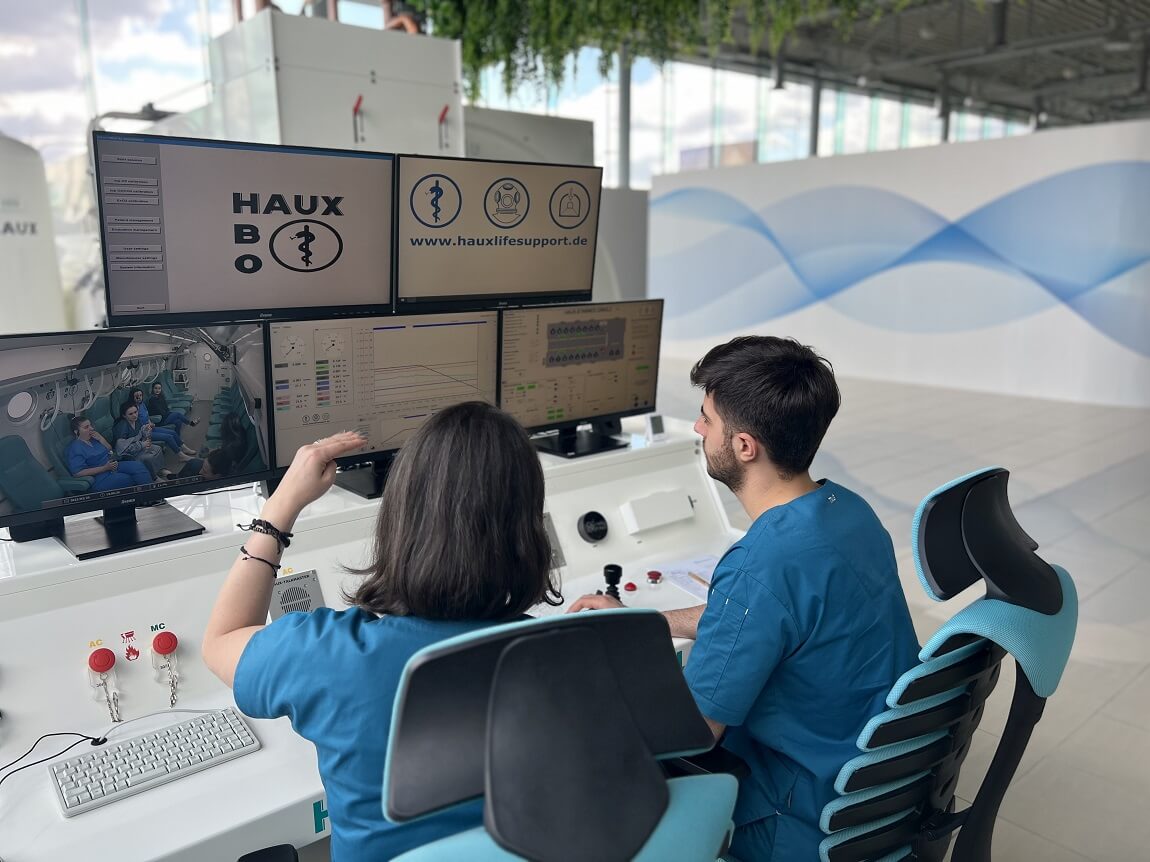
How much does a hyperbaric therapy session cost?
Before comparing the prices of therapy in the hyperbaric chamber, the most important thing is to make sure you know the main differences between HBOT and mHBOT chambers. The most important, but not the only technical differences are given by the purity of the oxygen used during therapy, as well as the working pressure, expressed in absolute atmospheres (ATA). The prices of a hyperbaric therapy session vary considerably depending on the type of hyperbaric chamber used.
The price of a hyperbaric therapy session in HBOT chambers
In Romania, the price of a therapy session in HBOT chambers (medical devices) usually varies between €80 and €140. In most countries with well-developed medical systems, such as Austria, Germany, France or Italy, the price of a session often exceeds 300 Euros, reaching in some clinics even up to 600 Euros. HBOT chambers, certified under Class IIB according to EEC 93/42, operate with pure medical oxygen (100%) and can reach a working pressure of up to 3 ATA. These have a rigid shell and can accommodate between 1 and 30 people. In Romania, HBOT chambers require accreditation from ANMDM and from health authorities. The operation of an HBOT chamber is permitted only in the presence of qualified medical personnel and periodically certified operators.
The price of a session at Hyperbarium Clinic
At the Hyperbarium Oradea clinic, the cost of a single session in the hyperbaric chamber is €100, and the cost decreases to €80 for a minimum of 20 sessions.

Consultation
/ Consultation & Follow-up
- Specialist consultation
- Multidisciplinary evaluation
- Specialist doctor follow-up

1 Session
/ session
- 1-3h oxygen therapy session
- Continuous 360° monitoring
- Medical supervision

Package of 20 sessions
/session
- 20 Oxygen therapy sessions (1-3h)
- Continuous 360° monitoring
- Medical supervision
The price of a therapy session in mHBOT capsules
In mHBOT (non-medical) hyperbaric chambers or capsules, the duration of a session usually varies between 60 and 90 minutes. The pressure in these capsules is approximately 1.3 ATA, and the oxygen purity can vary between 24% and 90%, without a mandatory minimum standard for these characteristics. The price of a session in such capsules in Romania usually varies between €36 and €60.
Although European regulations prohibit the promotion of mHBOT chambers in the context of medical treatments, some beauty salons and certain medical clinics promote therapies in mHBOT chambers as medical treatment. This creates confusion for both patients and some doctors, who often receive unclear information about the real characteristics of hyperbaric chambers.
It is important to note that the ATA pressure includes the value of atmospheric pressure (1 bar) plus the value of additional pressure in the hyperbaric chamber. Thus, in reality, we must compare 2 bar with 0.3 bar, the latter being the value found in most non-medical mHBOT chambers. Due to their significantly inferior characteristics, mHBOT (non-medical) chambers are approved for only one condition (Acute Mountain Sickness) and should in no way be used for other conditions where hyperbaric therapy is indicated.
Read here for a more detailed comparison of types of hyperbaric chambers and additional information about prices of hyperbaric therapy sessions.
Is hyperbaric therapy settled by CAS?
Although most patients are directed to treatment through a medical recommendation, unfortunately, in Romania hyperbaric therapy is not yet settled by CAS. In the United States, it is FDA-approved for 16 conditions, including decompression sickness, carbon monoxide poisoning, gas embolism, gas gangrene, crush syndrome/polytrauma, burns, acute hearing loss, diabetes-related conditions, or aseptic bone necrosis. At the European level, hyperbaric therapy is approved for 30 different conditions, and new conditions are studied annually for their possible inclusion in this list.
What should you expect after a hyperbaric therapy session?
Toward the end of a hyperbaric therapy session, the medical staff will gradually reduce the pressure inside the chamber to allow your body to adjust to the outside pressure. You will be helped to remove your mask and you will be guided to the exit of the room. Next, your vital signs will be checked, including your blood pressure and pulse, and if you have diabetes, your blood sugar levels will also be checked. Once the doctor determines that all parameters are normal, monitoring is no longer necessary and you can change back into your clothes and leave. You may feel slightly tired or hungry after the treatment, due to the increased calorie consumption during the therapy.
What are the results of hyperbaric therapy?
The effectiveness of hyperbaric oxygen therapy can vary depending on the condition in question and the individual patient's condition. The physician can assess the likelihood of success of hyperbaric therapy based on various factors, including the type and severity of the condition being treated, the patient's medical history, and the results of existing clinical studies and research. In general, doctors consider:
- Scientific evidence: If there are clinical trials or research supporting the effectiveness of hyperbaric therapy for a particular condition.
- Patient's general condition: The patient's general health, including any other conditions they may have and how these may affect the response to therapy.
- Response to previous treatments: How the patient has responded to other treatments for the same condition.
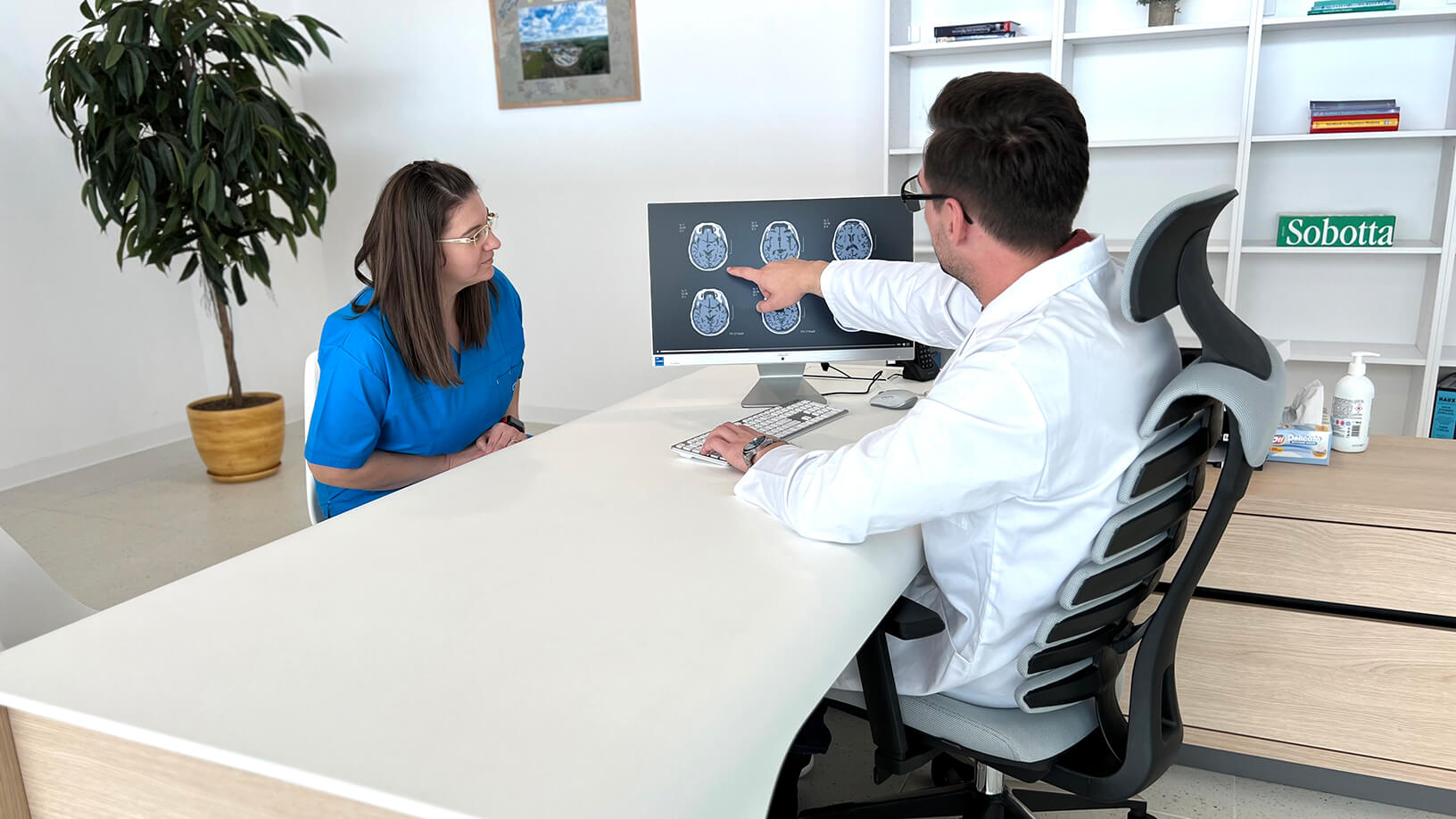
Based on this assessment, the doctor can provide an informed estimate of the likelihood of success of hyperbaric therapy in the patient's specific case.
What are the risks and contraindications?
Hyperbaric therapy is considered a safe and reliable treatment, with very little risk of complications. Side effects are generally minor, especially when the duration of treatment does not exceed 3 hours and the pressure inside the chamber is kept below 3 ATA.
The most common side effect of hyperbaric therapy is barotrauma, a condition that manifests as discomfort or pain in the ear. This occurs when there is a difference in pressure on either side of the eardrum, similar to the sensation experienced during takeoff. Other contraindications for hyperbaric therapy include:
- Pneumothorax: The presence of air or gas in the pleural cavity, which can be aggravated by the increased pressure in the hyperbaric chamber.
- Some lung conditions: Severe lung disease, such as emphysema with large bubbles, can increase the risk of lung collapse under pressure.
- Pheochromocytoma: A tumor of the adrenal gland that can secrete hormones uncontrollably under pressure.
- Drug conditions: Some drugs, such as doxorubicin (a chemotherapy agent) and cisplatin, can have adverse interactions with high-pressure oxygen.
- History of seizures: Patients with a history of seizures, especially uncontrolled seizures, may be at increased risk of seizures during hyperbaric therapy.
- Pregnancy: Although not an absolute contraindication, the use of hyperbaric therapy during pregnancy requires caution and should be carefully evaluated.
- Severe claustrophobia: Because the therapy requires staying in a closed room, people with severe claustrophobia may have difficulty.
- Middle ear implants: Certain types of middle ear implants may be affected by the pressure in the hyperbaric chamber.
It is important that anyone considering hyperbaric therapy speak with a medical professional to assess the risks and benefits in the context of their condition and individual medical history. The team of specialist doctors at the Hyperbarium clinic is at your disposal for consultation and assessment. Schedule a consultation to discuss the possibilities and benefits of hyperbaric therapy tailored to your needs.
What makes the Hyperbarium clinic exceptional?
Clinica Hyperbarium is one of the most advanced and modern hyperbaric medicine centers in Romania. Located next to Băile Felix, it offers patients a variety of recovery therapies for a wide range of acute and chronic conditions. The clinic covers an area of over 3,000 square meters and offers state-of-the-art treatment conditions in a modern space.
The entire staff is trained and certified according to European standards, and the team doctors have skills in hyperbaric medicine. The medical director of the clinic is Dr. Ciprian Sturz, a surgeon specializing in general surgery, visceral and emergency surgery. Dr. Ciprian Sturz returned to his hometown to get involved in this project, after more than 15 years of experience in some of the most prestigious hospitals in Germany.
- The entire staff of the clinic is trained and certified at European level by the German manufacturer of the hyperbaric chamber, ensuring the highest standards of therapy.
- Doctors within the clinic have skills in hyperbaric medicine, according to Order of the Minister of Health no. 418/2005, always applying treatment schemes targeted and regulated by the European Committee for Hyperbaric Medicine (ECMH)
- The integrated telemedicine system allows parallel monitoring of hyperbaric treatment by specialist doctors located in international medical centers of excellence.
Watch the video below with the virtual tour of the Hyperbarium clinic to convince yourself of its professionalism, as well as its modern facilities.
If you are convinced of the quality of our services, we invite you to make an appointment.
Hyperbarium Articles
Keep up to date with the latest news in hyperbaric medicine. Accurate medical information in articles verified by experienced medical specialists.






